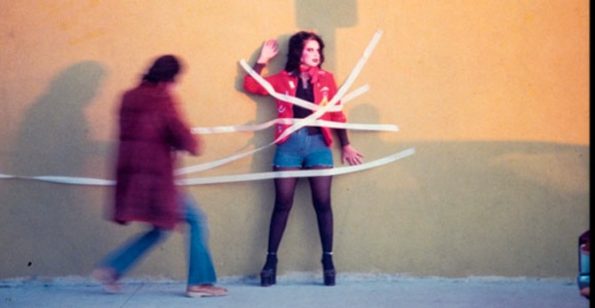Search
To search for an exact match, type the word or phrase you want in quotation marks.
A*DESK has been offering since 2002 contents about criticism and contemporary art. A*DESK has become consolidated thanks to all those who have believed in the project, all those who have followed us, debating, participating and collaborating. Many people have collaborated with A*DESK, and continue to do so. Their efforts, knowledge and belief in the project are what make it grow internationally. At A*DESK we have also generated work for over one hundred professionals in culture, from small collaborations with reviews and classes, to more prolonged and intense collaborations.
At A*DESK we believe in the need for free and universal access to culture and knowledge. We want to carry on being independent, remaining open to more ideas and opinions. If you believe in A*DESK, we need your backing to be able to continue. You can now participate in the project by supporting it. You can choose how much you want to contribute to the project.
You can decide how much you want to bring to the project.

The exhibition “Asco: Élite de lo oscuro: 1972-1987” (MUAC, México), based on a reactivation of the archive, offers a complete vision of the multiple and complex practices of Asco, a platform that brought together different Chicano artists and was characterised by the setting in motion of performative strategies that re-politicized the urban space of the city of Los Angeles.
Asco, nausea, disgust… or how political subjects appropriate offensive and damaging language in order to grant themselves the very agency they have been divested of. The choice of the name by these Chicano artists from the East of Los Angeles puts on the table a range of extremely complex questions that gravitate around possibilities for the (re)materialization of these bodies in an urban context, where disintegration becomes geography.
Asco is the nausea produced by exclusion, by the embedded discrimination agaisnt the North American Chicano community within which the group is gestated. But Asco is neither a group nor a collective it is a space for experimentation. Ductile, open, permeable… bringing together those who at certain moments with their proposals joined a core nucleus made up of Pattsi Valdez, Harry Gamboa, Willie Herrón and Gronk. It was a mobile experience in which individual authorship was diluted.
The visit to the exhibition raises, first, the eternal doubts about the pertinence of institutionalizing a type of contra-cultural practice that in its day wasn’t just far removed from the North American artistic mainstream and their historiographical stories, so much as virulently reacted against it, as shown by the action Spray Paint LACMA (1972). One response to the racism that the Los Angeles County Museum of Art glorified in was excluding Chicanos from its programme, alleging that they were incapable of doing anything beyond folkloric art. Various members of Asco wrote their Hispanic names on the façade of the museum, in an act that appropriated not only the institution but also a technique, graffiti, the sign of identity of the Chicano gangs.
One important aspect is that this is the first retrospective exhibition of Asco in Mexico, where it seems their practices are not as well known as one might presume. The exhibition has actually travelled from the Los Angeles County Museum of Art, which demonstrates a desire to include Asco in a genealogy of Los Angeles and North American art, situating it as an antecedent of a whole series of current productions negotiating discourses derived from postmodernity. In turn it sets in motion an operation to rescue some practices that decentralize the official history of art, permitting the entrance of the non-Anglo-Saxon. One will have to wait to see how it is received in Mexico, the country from where the families of a major part of the members of Asco originated. The inaugural lecture in the MUAC, a dialogue between Harry Gamboa and the curators of the show (Rita González and C. Ondine Chavoya) was entirely in English, as Gamboa, son of Mexican immigrants but born in LA, doesn’t speak Spanish. This fact is relevant as it confronts us with the reality of Mexican immigration in the forties and fifties in the USA, a massive migration backed by the so-called “Bracero program”, a bilateral agreement that arose out of the demand for farm labourers due to the Second World War. Despite being legal immigrants, their working conditions bordered on slavery and the social ostracism to which they were condemned led them to reject a language that many didn’t then teach their children.
A profound criticism of (and from) this Chicano condition marks a large part of Asco’s work. Their practices don’t just react against the sociocultural invisibility of the Chicano in the United States. Their aesthetic strategy implies a response to the very tradition of Chicano art, centred on a type of figurative, narrative mural. In this context, their performative practices became a political-aesthetic tool of the first order, given that as well as making the visibility and appropriation of the public space possible, they also established a formal rupture charged with ideological connotations.
In Instant Mural (1974) Gronk stuck Patssi Valdez to the wall with insulating tape, converting her into a street wall that apart from ironizing about the Mexican tradition also fixes in the urban space a body marked by race and gender. The photograph that documents the action underlines the ephemeral and spontaneous nature that characterised many of Asco’s practices. The accent is placed on the appearance of a body that threatens the marked racial segregation implicit in LA’s geography.
The bodies that Asco staged are bodies bereft of representation. Invisible bodies, in the era of the boom of television and mass media. These bodies are archives, receptacles of a living migrant genealogy. Through the aesthetic gesture they produce a distancing effect that enables them to situate themselves outwith it, from where it is possible to question critically a specific historic-artistic moment. Through performance, they make visible what the American society endeavoured to make invisible: their race, their presence, the discrimination…The occupation of the public space by these bodies and their desires opens up the way to its possible reconfiguration.

Maite Garbayo is a writer and researcher. Art history, feminist crticial theory and pyschoanalysis are a few of the tools of her trade. She combines her research and writing with periods of teaching. Currently, she is working on her doctoral thesis and is the editor of the magazine {Pipa}.
"A desk is a dangerous place from which to watch the world" (John Le Carré)